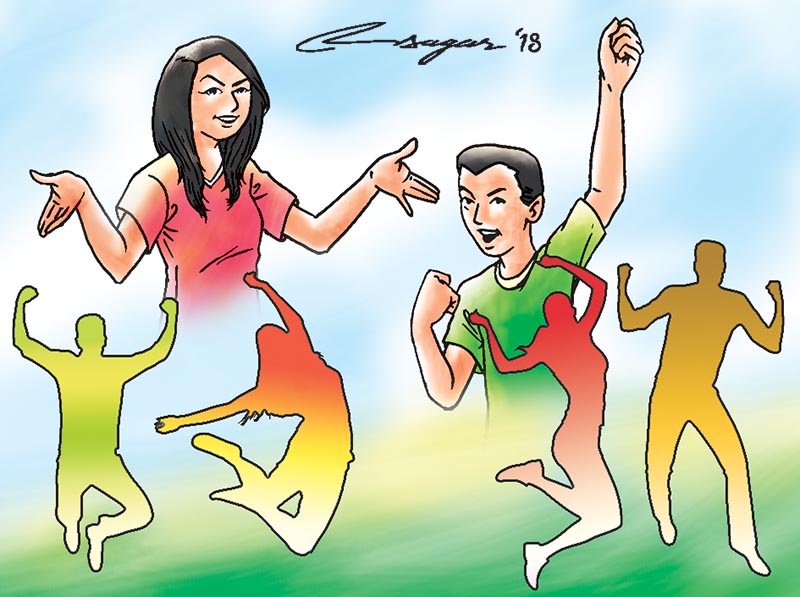Empowering the youth: Give them safe spaces
Youth need safe spaces where they can come together, engage in activities related to their diverse needs and interests, participate in decision-making processes and freely express themselves
The theme for this year’s International Youth Day, which was observed on Sunday, is Safe Spaces for Youth. Youth need safe spaces where they can come together, engage in activities related to their diverse needs and interests, participate in decision-making processes and freely express themselves.
While there are many types of spaces, safe spaces ensure the dignity and safety of youth. Safe spaces such as civic spaces enable youth to engage in governance issues; public spaces afford youth the opportunity to participate in sports and other leisure activities in the community; digital spaces help youth interact virtually across borders with everyone; and well planned physical spaces can help accommodate the needs of diverse youth especially those vulnerable to marginalisation or violence.
Different countries have defined the youth age in different ways. From the viewpoint of physical and mental development, youth denotes the age group falling between the state of adolescence and adulthood. This is the most active, energetic and dynamic group. A look at the experience of various countries of the world also shows that the age group of the youth seems to be different. In most of the countries, the youth age has been fixed in between 15 and 35 years whereas international organisations like the United Nations and the World Bank have considered the age group of 15 to 24 years as of the youth.
In the context of Nepal, the National Youth Council Act, 2015 has fixed the age group of 16 to 40 years as youth age. If the age group of 16 to 40 years of Nepali population is viewed, it seems to cover 40.35 per cent of the total population.
In the context of uniformity yet to be introduced in regard to the growth age group in different bodies of Nepal Government, “Youth Vision-2015” has classified it into two age groups of 16 to 24 years and 25 to 40 years and the group-wise priorities have been determined accordingly. Present Status of the Youth in Nepal has been placed at 77th in the world youth development indicator. Even if compared to South Asian countries, the youth development indicator of Nepal seems to be the weakest. Even though the ratio of fully unemployed youth in Nepal has been shown merely at 2.3 per cent in the government figures, the ratio of semi-employed youth is about 36 per cent.
According to the International Labour Organisation, the fully unemployed ratio is 19.2 per cent whereas the semi-unemployed ratio is 28.3 per cent. Nearly 36 per cent of the unemployed youth force in Nepal is not connected with economic production and skills. The marginalised, minority, indigenous and physically challenged youth suffer from the higher ratio of unemployment.
Almost half of the youth labour force is still dependent on agriculture for survival. Around 7 per cent of the youth annually going out for foreign employment are unskilled. Even though the employment ratio looks slightly bigger, this ratio has decreased in the industrial sector. Even though remittance’s contribution in the GDP is quite substantial, only a small part of this is invested in the production sector.
Youth inclusion and participation in the decision-making process is more likely to be successful if young people are empowered and given opportunities to work with local and national governments. With few constructive avenues to influence local and national politics, young people in Nepal tend to view governments as exclusive. Conversely, governments often fail to consider the views of youth in policy-making and may have different development priorities. Having a youth-focused quota system with specific criteria that promotes inclusiveness of marginalised and vulnerable youth recognises the special needs of youth, and can help to increase youth active participation in decision making positions at all levels and in all public spaces.
Creating youth platforms is vital to engage youths as social actors with their own views and contributions. The creation of spaces for youth to express their opinion to decision-makers and broader society ensures that they have the opportunity to be heard. Providing spaces for youth to have open and frank engagement with government, international community, communities and each other to exchange views and promote dialogue on social, economic and political situation can help bridge the divide, build trust and legitimise youth by changing negative attitudes towards them. Increasing awareness about their rights and responsibilities and promoting equality among all genders and reducing caste-based and religious discriminations are the need of the hour.
Ensuring that safe spaces are inclusive, youth from diverse backgrounds especially those from outside the local community, need to be assured of respect and self-worth. In humanitarian or conflict-prone settings, for example, youth may lack the space to fully express themselves without feeling uncomfortable or unwelcome. Similarly, without the existence of safe spaces, youth from different race/ethnicity, gender, religious affiliation or cultural background may feel intimidated to freely contribute to the community. When youth have safe spaces to engage, they can effectively contribute to development, including peace and social cohesion.
Banjade is president of UN Youth Nepal






